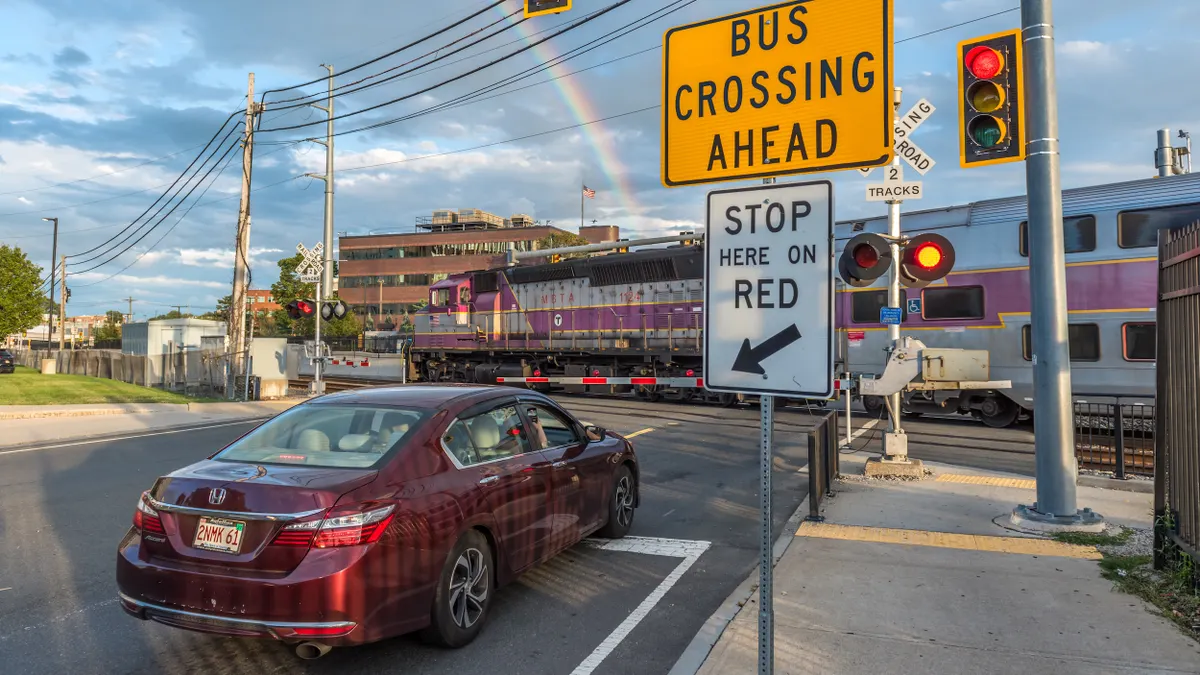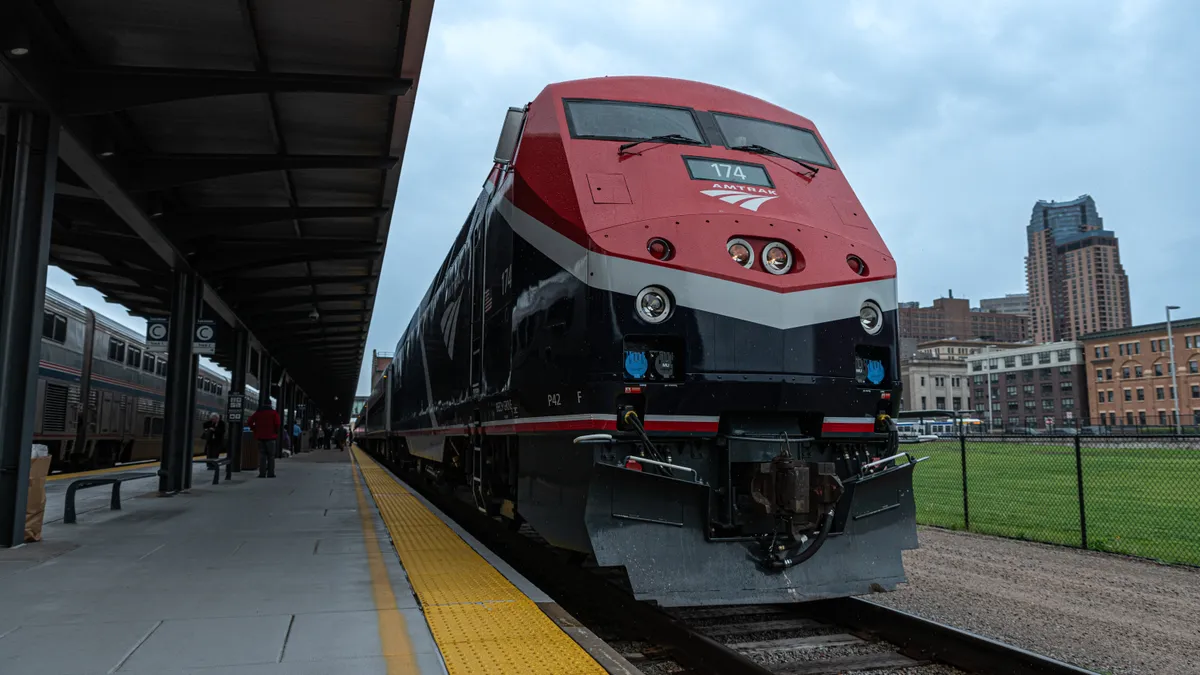LOS ANGELES — If cities are to ease congestion, they will need to embrace all kinds of options, including flying taxis, autonomous vehicles (AVs) and transit, as well as congestion pricing and other strategies to curb car usage.
Those were the major points of emphasis at the second and final day of LA CoMotion, a conference in Los Angeles that discussed the future of mobility and how it can be used to give people options beyond their personal vehicles.
"We know that to meet our emissions goals, we need fuel efficiency, no question. We need changes in land use, no question," Seleta Reynolds, general manager of the Los Angeles Department of Transportation (LADOT) said during a panel discussion. "But none of that's going to be enough. People have to drive less."
To do that, several speakers spoke in favor of congestion pricing, which has been successful in cities like London and has been discussed and proposed in New York City as a way to curb gridlock. Surveys have shown there is also broad support among the public, many of whom are willing to pay higher taxes and tolls if it means more investment in infrastructure.
With Los Angeles experiencing struggles of its own to get congestion under control and do its part to reduce carbon emissions, speakers expressed support for a similar plan in the city. Phillip Washington, CEO of the LA Metro transit system, said congestion pricing is "the biggest thing that we can do to reduce congestion."
The city continues to explore ways to get its residents out of their cars in what has traditionally been an automobile-dominated environment. That includes partnering with dockless bike- and scooter-sharing companies Lime and Spin to share data on usage, while new ride-hailing pilot programs have launched and the Metro transit system is the subject of higher investment.
Speakers said that for lasting change, giving people options beyond using their cars is one part of the solution, but giving them a financial incentive will create long-term progress.
"We know that we can get about 8% mode change by giving people options. But you don't get to 30% unless you have consequences," Reynolds said.
Flying taxis: A 'new Wright brothers era'?
While many proposed solutions to congestion are street-based, two panelists spoke of the work being done to use the skies above cities as another outlet to reduce gridlock and cut travel times.
Ride-hailing giant Uber has targeted Los Angeles and Dallas-Fort Worth for the launch of its uberAIR service, which will provide on-demand flying taxis to get residents and visitors around at altitude of 1,500 feet. Uber is partnering with the likes of NASA and the University of Texas at Austin on the technology, and aims to have autonomous taxis in the sky in the next decade.
Given the clogged roads, Mark Moore, Uber's Engineering Director of Aviation, said the move toward travel in the sky will help people be more efficient, and that those on the ground will not notice the vehicles.
"The idea is that this helps to connect us and keep cities very, very productive," Moore said during a panel discussion. “What's really exciting about these vehicles when you fly above congestion, they're not helicopters. These new types of vehicles are incredibly quiet, they're designed with redundancies so that they're ultra-safe, so it is completely different from aircraft or helicopters today."
The taxis will be available at what uberAIR has dubbed a "skyport." A route across Los Angeles, which would normally take well over an hour by car, would take 10 minutes, Moore said.
The technology is also in an exciting phase. Moore said there are more than 100 types of vehicles under development, and uberAIR plans to have between 10 and 20 aircrafts in public use by 2020. Fabien Nestmann, head of Global Public Affairs at helicopter company Volocopter, said there are at least 80 startups in the flying car space now, a vast increase on just a few years ago.
"We're very much in a new Wright brothers era, where nobody knows exactly what the vehicles should look like to take advantage of this new technology, so everybody's trying different things," Moore said. The taxis are intended for use by everyone, rather than just the rich, and Moore said there could potentially be "millions of trips per day in a city like Los Angeles."
The "skyports" will not be in residential neighborhoods, however. Nestmann noted while there may be some uncertainty among the public about the growth and use of flying taxis, education is key.
"I think it's really important to show people what an air taxi looks like, how it sounds, what it feels like, to take away any fear that there may be," he said.
Public, private cooperation on AV rollout
On the ground, speakers looked ahead to the growth in use of AVs, particularly as they could improve safety. Estonia’s Minister of Economic Affairs and Infrastructure Kadri Simson pointed to the statistic that 70 people per day on average die on Europe’s roads, with another 350 injured. And most of those deaths and injuries are down to driver error, like in the United States.
"Those numbers can be improved by delegating the tasks of driving to technology,” Simson said in a speech.
It might be a tricky path to get to rolling out AVs fully in cities, with incidents like the fatal pedestrian crash in Tempe, AZ leading to cities and automakers reconsidering tests and trying to allay public fears.
Reynolds said city governments must change the way they think about innovative solutions and encourage such work, as they "will not be able to regulate our way to future desire." Instead, partnering with the private sector is key. "We require each other in order to succeed," she said.
And there appears to be a willingness among at least some of the companies developing AVs. Major automakers are all in various stages of testing and development, while the likes of Google subsidiary Waymo are working hard to roll out AVs and continue to test them in the real world.
Ellie Casson, head of local policy for Waymo, said while the private sector can lead the way on the technology, they need to work in good faith with cities and public sector leaders, as there are areas where their expertise is not as high.
"We can't grow and do what we need to do if we don't have partners in the city,” Casson said. "There's just so much that we don't understand. We can be the experts on the tech part, but then how actually interacts with the real world, we need to turn to people who work with residents of these cities. We are very aware that we can't be arrogant about things, we need to be relatively humble and ask for help."
And while the technology is exciting, there were some calls to truly understand how it works and what benefits it will bring. Advocates have said AVs will mean increased safety and will free people up to be productive instead of concentrating on driving, but others said it presents a dilemma.
"What I would love to see more public discussion of is: what does all this technology development mean to all of us? Do we want to live like this? Do we want to use all this available technology?” Peter Schwarzenbauer, a member of the BMW Group’s Board of Management, said during a roundtable discussion with reporters. “I am not seeing really too much public discussion about it."
There could be some very tricky times ahead as AVs hit public streets — however far out that may be. Experts said there will be a transition phase where some cars will be fully autonomous while others will not be, making things difficult for cities and their residents in the interim before their quality of life goes on the upswing.
"Imagine a phase where you have extremely smart cars and still extremely stupid cars on the streets,” Schwarzenbauer said. “How do we organize all this? There's a lot of questions, and we don't have a clear answer yet."
"We can't grow and do what we need to do if we don't have partners in the city. There's just so much that we don't understand."

Ellie Casson
Head of Local Policy, Waymo
Public transportation and ride-hailing
There needs to be different thinking around public transportation, speakers said, with many adding that ride-hailing and other mobility services could serve in a complementary way, especially to solve the "first mile, last mile" problem.
Moves are already afoot in Los Angeles, which is experimenting with microtransit to connect riders with bus and Metro stations. Joshua Schank, chief innovation officer at LA Metro, said such partnerships are key to help get people out of their cars and onto transit, and also will be helpful for low-income neighborhoods and residents that are not well served.
"That's the type of experimentation that we have to undertake in order to figure out how to do things better," he said.
Meanwhile, there are continued calls to think differently about development around transit stations, which is traditionally referred to as "transit-oriented development," but Washington said he prefers to think of as "transit-oriented communities." That means finding ways to encourage amenities that make the surrounding area vibrant, like grocery stores, affordable housing and pedestrian facilities.
Reynolds also noted zoning rules have been streamlined around transit stations thanks to a provision in a ballot measure that voters overwhelmingly passed, meaning that the city planning director has more latitude in encouraging greater density.
Ride-hailing and other mobility innovations have been blamed for taking riders away from public transportation, but Michael Hurwitz, Transport for London’s director of transport innovation, said the city can find ways to work with them if they are willing to complement existing service. The city has had a fraught relationship with Uber, but Hurwitz said he is keen to embrace new companies coming in if they keep to a criteria he judges them by.
"I love a new mobility service if it can get people to a transit hub,” he said. “I think it's fantastic if you can allow people who are less able to remain socially and economically active. I like it less if you're going to take 65 people out of a London double decker bus and smear them into 50 pods," Hurwitz said.
Schank said there is value in thinking of transit as a public good — like gas, electricity or water— that everyone is able to use easily and on demand so long as they pay their taxes. He said that, while schemes like Estonia’s which make all transit free definitely has its upsides, it can be tough to get approval from voters and elected leaders for the taxpayer-backed subsidies required.
"I love the idea that public transit is a thing that everyone can use at any time as much as they want, as long as they're paying their taxes,” Schank said. “It sounds like a public utility that way, and I think it makes it so much more customer-friendly when you do that, than the current experience, where the challenge of transit is how to pay for it in the first place."




















